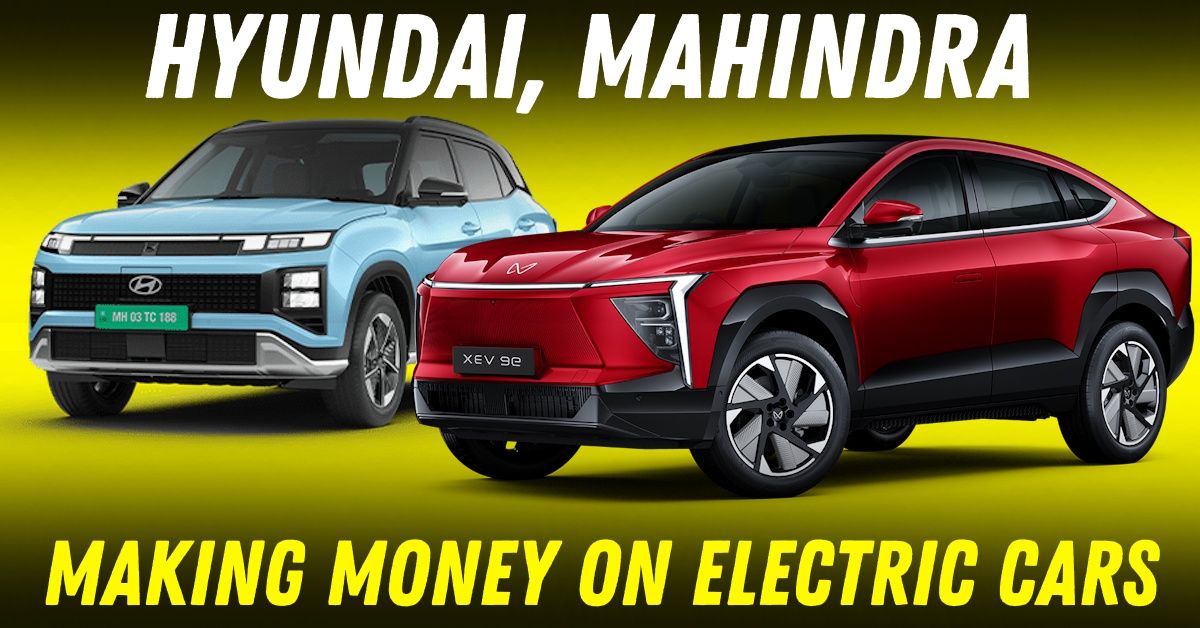After Tata Motors, Mahindra And Hyundai Have Begun Making Profits On EVs: Here's Why


India’s electric vehicle (EV) market has reached a turning point, not just in terms of volumes, but in viability. After years of losses and cautious optimism, three automakers have finally turned the corner. Tata Motors, Mahindra, and Hyundai have each cracked the code to EV profitability. What was once a loss-leading business backed by subsidies is now standing on its own feet, with bottom lines starting to reflect the promise of a sustainable future.
Tata Motors, the early front-runner in India’s EV race, hit a major milestone in FY25. Despite ceding some market share, dropping from a dominant 70% to a still-leading 53%, Tata’s EV division posted a positive EBITDA margin of 1.2%, reversing the negative 7.1% recorded the year before. Notably, the company managed a ₹100 crore profit before tax in the December quarter, achieved independently of any production-linked incentive (PLI) scheme support.
Mahindra followed close behind, entering the black in the final quarter of FY25. Its new electric offerings, the BE 6 and XUV.e9, proved to be the right bet. These premium SUVs, priced between ₹20 and ₹31 lakh, not only helped Mahindra win 37% of the revenue market share in the electric SUV space but also delivered strong pre-order value, crossing ₹8,400 crore in bookings.
Hyundai, a more recent entrant to the EV scene, has also hit a profitable stride. The Creta EV, launched in January 2025, reached unit-level profitability after accounting for initial launch spends and promotional costs.
The playbook these automakers followed offers lessons for the broader industry.
First, localisation has been crucial. Tata has brought more of its battery pack and component production in-house. Hyundai pushed even further, hitting 92% localisation and sourcing over 1,200 parts from within India, resulting in foreign exchange savings of nearly ₹5,700 crore since 2019. This has not only shielded these companies from currency fluctuations but also cut costs significantly.
Second, they’ve stayed away from the race to the bottom in pricing. Instead of flooding the market with budget EVs, Mahindra and Tata focused on premium positioning, where higher margins help cover the initial costs of electrification. With waiting lists and strong demand, the strategy has paid off.
Finally, while PLI schemes have certainly helped, these profitability milestones were reached even without relying on subsidies. This indicates that the business models are now structurally viable, not artificially supported.
The shift is not purely internal. The broader EV ecosystem has matured, too. Annual passenger EV sales have now crossed the one lakh mark in India, helping manufacturers scale production and reduce costs per unit.
Competition has also intensified. MG Motor, for instance, has made strong inroads, which in turn forced Tata to tighten operations and focus on efficiency rather than chasing market share. The result is a leaner, more financially stable operation.
Government policy continues to provide tailwinds. The recently launched PM E-DRIVE scheme with an outlay of ₹10,900 crore, the ₹3,400 crore eBus Sewa initiative, and a nearly doubled auto sector budget in the 2025–26 Union Budget have all contributed to building a supportive environment for EV expansion.
Mahindra is already preparing for its next phase with plans to launch five more electric vehicles and seven new SUVs by the end of the decade. Tata, meanwhile, continues to develop its product mix with models like the Harrier.ev, which are expected to strengthen margins and appeal to a broader audience.
This profitability isn’t just good news for companies, it’s a sign that the electric transition is entering a more mature phase. For consumers, that could mean better-built vehicles, more widespread service networks, and more realistic pricing. As battery prices decline and charging infrastructure improves, the need for deep discounts and government handholding will fade.
What we’re witnessing is the emergence of an electric vehicle industry that can finally stand on its own. It’s no longer about ‘when’ EVs will become viable. That moment has arrived, and the first three companies to prove it have laid the foundation for others to follow.